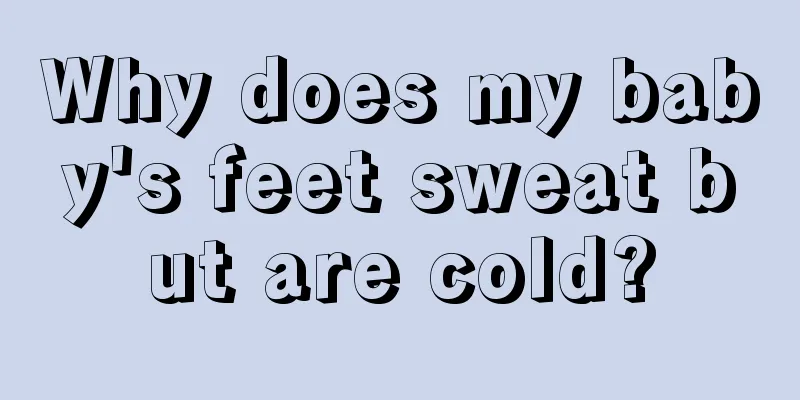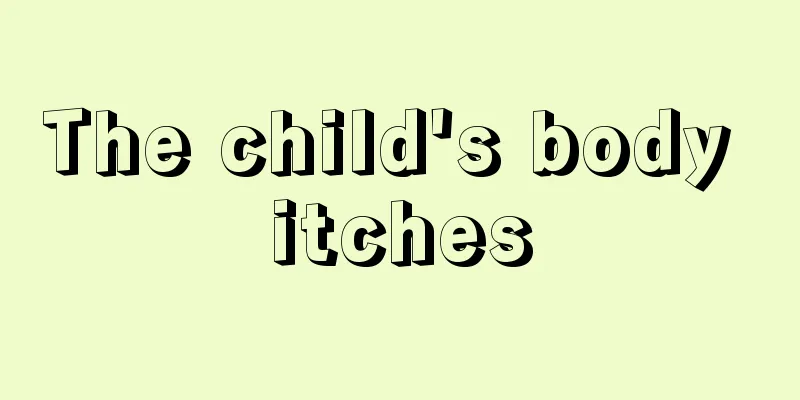Why does my baby's feet sweat but are cold?

|
When the body is hot, it will sweat, which is a very normal physiological phenomenon. Especially in summer, almost everyone sweats a lot, which is actually a good thing because sweating can remove a certain amount of toxins from the body and is good for health. If you sweat profusely, it is not normal and you need to go to the hospital for examination and treatment. So, why is it that the baby's feet are sweaty but cold? In fact, it is normal for children to have cold hands and feet. If their hands and feet are hot, it proves that they are wearing too many clothes. Why is the situation different for children and adults? This starts with the fact that humans are warm-blooded animals. Most mammals and birds are homeothermic animals, which means that as long as the external temperature changes are not too extreme, we can rely on the body's temperature regulation function to keep the body temperature basically constant near a certain value. Animals with good temperature control abilities tend to be very energetic and often occupy a higher position in the food chain. Correct a common sense that was deceived by the biology teacher: Although fish are basically cold-blooded animals, sharks and swordfish at the top of the food chain can actually maintain their body temperature and are close to being homeothermic animals. The dinosaurs, the dominant cold-blooded reptiles, were also likely semi-warm-blooded. The disadvantage of homeothermic animals is that once the temperature becomes too high or too low, the body's temperature regulation function fails and they may face the dilemma of even losing their lives. When the temperature is lower in winter, in order to maintain body temperature and mobility, on the one hand, we need to rely on cold protection, clothing, fat, and fur to retain heat; on the other hand, we need to increase the heat produced to make up for the greater heat lost. There are several ways for the human body to generate heat. Normally, most of the heat comes from basal metabolism, that is, the heat generated by the normal survival of the human body, such as breathing, heartbeat, etc. When at rest, this part of the heat can account for about 80%. When extra calories are needed to resist the cold, increasing the amount of exercise, increasing heat production by secreting hormones, or shivering are the most common ways for the human body to increase calories. The elderly and children are the two groups most likely to have low hand and foot temperatures, so the elderly are very worried about children having cold hands and feet. But in fact, the reasons why the hands and feet of these two types of people have low temperatures are completely different. The human body's metabolic rate gradually slows down with age. The elderly have a slower metabolic rate and their body produces less heat, so cold hands and feet are a common problem for the elderly. At the same time, some common chronic diseases among the elderly, such as diabetes and anemia, will aggravate the symptoms of low hand and foot temperature. Children are in the stage of their life when they grow fastest and have the fastest metabolism. Both heart rate and breathing rate are nearly twice that of adults. Heat is related to the metabolic rate, which is why we always say that children are not afraid of cold, but are only afraid of being covered. Because children will generate a lot of heat, once they are covered too much, the heat cannot be dissipated, and they may sweat and develop prickly heat at the very least, or suffer from heatstroke or other febrile illnesses at the worst. Are cold hands and feet harmful to the body? The answer is: as long as the cold is not to the extent that it causes frostbite, it will not have any adverse effects on the body. The function of human feet is to dissipate heat and they are naturally designed to withstand cold. We have talked about this in detail in our previous article on how to put socks on children, so I will not repeat it here. Another point that needs to be made is that having cold hands and feet is a natural way for animals to resist the cold. The speed of heat dissipation depends on the temperature difference between the human body and the environment. The hotter the hands and feet, the faster the heat dissipation. In winter, if your hands and feet are too hot, you will lose heat faster, which is the opposite of keeping warm. The same principle applies to most homeothermic animals, which will reduce the blood supply to their skin and other parts in cold environments, leaving precious heat for core organs such as the heart and lungs. |
<<: Why do children have cold sweats and cold hands and feet?
>>: Why does the baby's upper tooth grow first?
Recommend
Why are there blue spots around baby's lips?
When a child first comes into this world, unless ...
What is the cause of the hard lump behind the child's ear?
Recently, many mothers have discovered that their...
Lymph nodes on the neck of a child
We all know that the neck is the most prone place...
What should children eat if they have excessive dampness in their bodies?
To address the problem of excessive moisture in t...
What to do if your baby coughs after sweating
Many parents will find that their babies will hav...
What are the dangers of mercury poisoning in children?
Mercury poisoning in children has serious impacts...
How to deal with newborn vomiting of breast milk
With the birth of a little life, it can bring a l...
White spots on children's tonsils
If you find white spots in the throats of many ch...
What are the symptoms of nasal hypertrophy in children?
Turbinate hypertrophy is a common chronic nasal d...
How many months does it take for a newborn baby to have teeth?
At what month is the latest for a newborn baby to...
What's wrong with the one-year-old baby's yellow hair?
Children are the angels of the family and the cry...
Is hydronephrosis easy to cure in children?
Children may also suffer from some congenital dis...
Treatment of true precocious puberty
Because people's living standards are much hi...
What to do if a one-year-old child has a fever
A one-year-old baby refers to a one-year-old baby...
What to do if your baby has a fever of 38.4 degrees
It is inevitable that babies will feel uncomforta...









